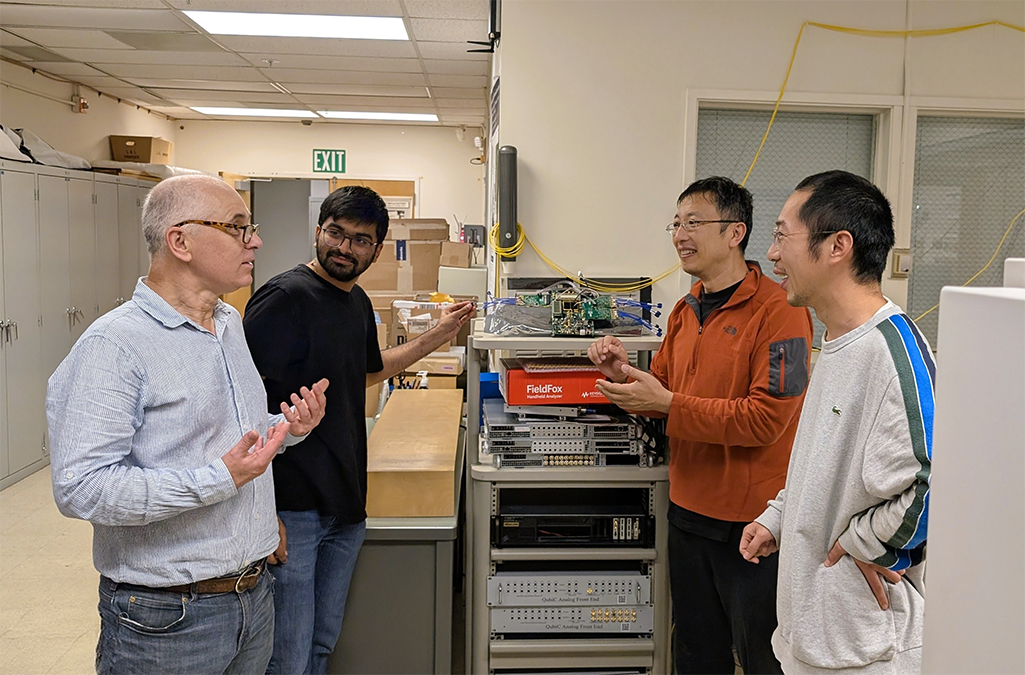Scientific Achievement
The unintentional interactions between neighboring qubits in quantum processors, known as crosstalk, pose a significant obstacle to achieving accurate large-scale quantum computations. These so-called coherent errors happen when a control pulse for one qubit influences nearby qubits and are difficult to detect and correct.
Now, a multi-disciplinary team led by the U.S. Department of Energy’s Lawrence Berkeley National Laboratory (Berkeley Lab) has demonstrated a practical, scalable, and experimentally validated method for modeling crosstalk in a multi-qubit superconducting quantum processor. The method enables researchers to investigate the dynamics of multi-qubit circuits without the need for new experiments, providing a diagnostic tool for characterizing whole-chip crosstalk.
The team included researchers from Berkeley Lab’s Accelerator Technology & Applied Physics Division, Applied Mathematics & Computational Research Division, and the National Energy Research Scientific Computing Center, as well as the Institute for Quantum Computing in Canada, Keysight Technologies, and the University of California, Berkeley.
Significance and Impact
Scalability and predictive power are key attributes of the method.
Scalability
This study not only presents a validated Hamiltonian model that considers the system’s total energy to describe its behavior and dynamics related to crosstalk, but also demonstrates a scalable experimental protocol for extracting Hamiltonian parameters across an entire chip. Importantly, the Field Programmable Gate Array (FPGA)-based quantum chip control system, called QubiC and developed by Berkeley Lab and the Advanced Quantum Testbed (AQT), enabled high-fidelity, large-scale, and phase-resolved experiments necessary for this work, highlighting the importance of low-level access to quantum hardware.
Precision Crosstalk Characterization

Statistical characterization of crosstalk strength β and phase θ measured for the chip using model in Eq. (6). a) Distribution of χ2/ν , green vertical line denotes median. b) There is no correlation between β and θ for the investigated chip.
The challenge was to develop a protocol for multi-qubit driving pulses that is highly sensitive to crosstalk and can learn from small samples of experimental data, while performing many precisely timed, phase-controlled simultaneous Rabi experiments across all qubit pairs with low noise and consistent calibration. QubiC addressed this challenge with its FPGA-based radio frequency system-on-chip (RFSoC) architecture, which provides dedicated processing cores for each qubit, real-time command execution, and nanosecond-level timing control.
Validation of Multi-Qubit Predictions Based on Two-Qubit Data

Graphical representation of the measured
crosstalk strength, β, between all qubits pairs on the chip. The edges with β > 0.1 are shown in red or blue depending on directionality. The edges with small β < 0.05 are not shown, other edges with intermediate β are shown in green. The thickness of edges is
correlated with magnitude of β. The printed values denote crosstalk (β, θ) of red or blue edges.
By leveraging QubiC’s ability to quickly reconfigure pulse parameters, the team collected crosstalk measurements for all functional qubit pairs on the chip. These results informed a Hamiltonian model capable of predicting crosstalk effects in simultaneous drive experiments involving three and four qubits—without requiring additional measurements. The cross-talk model predictions closely matched the experimental results, typically within an accuracy of about 4%, confirming both the model and the experimental approach. Without QubiC’s high-throughput, automated experiment management, gathering this amount of data and verifying the model would have taken a lot more time.
Path to Better Quantum Hardware and Control
The ability to model and predict crosstalk at the Hamiltonian level enables the pre-compilation of control pulses that counteract these coherent errors—a key step toward achieving higher-fidelity quantum gates. QubiC’s open-source, modular design allows other research groups to replicate and expand this methodology, accelerating progress in quantum error mitigation.
Research Details
The team developed a Hamiltonian-based model that describes the system’s dynamics in terms of its total energy. It predicts how control actions on one qubit can unintentionally influence others. By employing a set of innovative two-qubit measurements to evaluate coupling, decoherence, and crosstalk between qubit pairs, they identified crosstalk parameters that informed the model, enabling it to accurately predict distortions in multi-qubit circuits.
They experimentally validated the model using an 8-qubit transmon chip, a type of superconducting qubit hardware developed by Berkeley Lab and AQT, in conjunction with the QubiC FPGA-based control system, which provided the precision and throughput necessary for comprehensive, whole-chip crosstalk characterization.
The QubiC system consists of a:
- Hardware layer implemented on an AMD ZCU216 RFSoC board with FPGA-based pulse generation, dedicated per-qubit cores, and low-latency multi-channel synchronization.
- Firmware layer, which stores predefined pulse envelopes in FPGA block RAM for quick reuse, with dynamic updates to amplitude, phase, and frequency for each pulse.
- Software layer for compiling high-level quantum programs into binary FPGA commands, enabling automated execution of hundreds of experiments with minimal overhead.
The team characterized 49 qubit pairs and validated the Hamiltonian model by predicting and measuring three- and four-qubit crosstalk experiments.
Contact: Jan Balewski, Yilun Xu, Neel Vora, and Gang Huang
Researchers: Jan Balewski, Yilun Xu, Neel Vora, Gang Huang, David Santiago, and Irfan Siddiqi (Berkeley Lab); Adam Winick (Institute for Quantum Computing in Canada, and Q-CTRL in Australia); and Joseph Emerson (Institute for Quantum Computing in Canada).
Funding: This work was supported by the Office of Advanced Scientific Computing Research, Testbeds for Science program of the U.S. Department of Energy Office of Science, and utilized resources from the National Energy Research Scientific Computing Center at Berkeley Lab.
Publication: Balewski, J., Winick, A., Xu, Y., Vora, N., Huang, G., Santiago, D., Emerson, J., and Siddiqi, I. (2025). “First-principle crosstalk dynamics and Hamiltonian learning via Rabi experiments,” in Proceedings of the 23rd Annual International Conference on Mobile Systems, Applications and Services, June 23-27, 2025, Anaheim, California, pp. 765-770. https://doi.org/10.1145/3711875.3737654
For more information on ATAP News articles, contact caw@lbl.gov.
